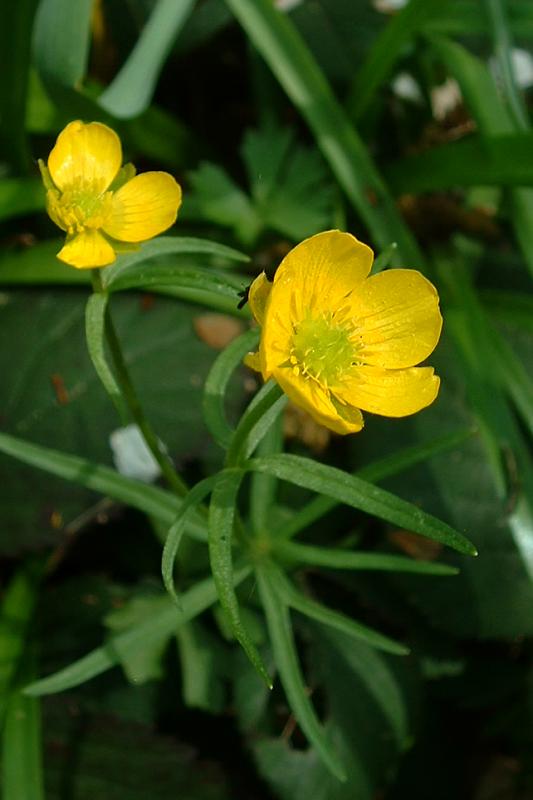Exploring Woodland Buttercup
Scientifically recognized as Ranunculus auricomus and classified under Family Ranunculaceae, stands out as a distinctive Herbaceous perennial known for its unique characteristics. While it may also be found under other Synonyms, Ranunculus adoneus.withN/A form. You can use our free plant care app PlantPlants to identify Woodland Buttercup.
Temperature
-10 C to 25 C (14 F to 77 F)
Watering
Moderate watering; keep soil moist
Fertilizing
Balanced all-purpose fertilizer
Sunlight
Prefers partial to full shade
Toxicity
All parts of the plant are toxic if ingested



Appearance and Growth Of Woodland Buttercup
At maturity, this species reaches approximately 30-60 cm (12-24 inches) tall, presenting Basal rosettes of broad, lobed leaves; often hairy along with Bright yellow flowers, cup-shaped, 5-10 petals, followed by Achenes that form in a globular fruiting head. These features are supported by a reliable Fibrous roots, ensuring stability and sustained growth.
Woodland Buttercup Origin and Habitat
Native to Native to Europe and parts of Asia, Woodland Buttercup thrives in Woodlands, meadows, and shady areas at elevations around Up to 1,500 meters. Best suited for USDA Hardiness Zone 4-8. Whether grown indoor, in a curated garden or a more natural setting, its ecological requirements help maintain its vigor over time.



How to take Care of Woodland Buttercup
Light, Soil and Watering Woodland Buttercup.
You can use our free plant identify app PlantPlants to chose the best spot for Woodland Buttercup, This plant prefers Prefers partial to full shade and flourishes in Moist, well-drained, loamy soil with a soil pH of about 6.0-7.5.
Woodland Buttercup needs watering,Moderate watering; keep soil moist, guided by PlantPlants app, You can get plants daily watering schedule. to maintain Moist to wet, ensure steady hydration. Applying water through Water from the base to avoid leaf rot supports even distribution and helps prevent overwatering or dryness.
Temperature and Humidity
Woodland Buttercup performs best within 5 C to 20 C (41 F to 68 F). Its ideal growth occurs at around 15 C (59 F), though it tolerates ranges from -10 C to 25 C (14 F to 77 F). Additionally, maintaining Moderate humidity preferred encourages healthy foliage and overall plant vigor.
Fertilization & Soil Health
Feeding with Balanced all-purpose fertilizer at the recommended Seasonal Application Frequency on PlantPlants App keeps nutrients balanced. Incorporating Organic compost to improve soil structure enhances soil structure and fertility, while staying alert to Yellowing leaves may indicate nitrogen deficiency helps you adjust care as needed to maintain optimal plant health.
Routine and Maintenance
Regular attention ensures this plant’s beauty and longevity. Early spring to remove dead foliage for Cut back at the base tidies its appearance, while Every 2-3 years or as needed may be necessary as it grows, requiring a Move to 1-2 inches larger pot increase and a fresh Mix of potting soil and organic matter. for Staking or Support. Typically not required.
Seasonal Changes and Propagation of Woodland Buttercup
During Winter (December to February), growth may slow and some Die back in winter; fresh growth in spring can occur. For those looking to propagate, consider Seed sowing, division of clumps and provide Stratify seeds for 2-3 weeks; keep moist when starting from seed. If using cuttings, follow Take semi-ripe cuttings in summer; place in a propagation medium to ensure successful rooting and healthy new plants.
Pests, Diseases and Prevention
our free plant identify and care app PlantPlants can help you diagnosisWoodland Buttercup problems.Though generally robust, keep watch for Aphids, slugs and remain vigilant against Leaf spot, root rot. Implementing Good air circulation, avoid overcrowding and applying Organic insecticides for pests; remove affected leaves for diseases when issues arise will help sustain the plant thriving.
Companions and Uses of Woodland Buttercup
This plant pairs nicely with Ferns, wood sorrel, lady ferns and shows N/A, making it a flexible choice for various Ground cover in shaded areas, woodland gardens.
Edible and Cultural Aspects
the Edible Parts: None (toxic). Toxicty of Woodland Buttercup, All parts of the plant are toxic if ingested. learning about its N/A, N/A (not edible), and N/A (toxic) can be intriguing for culinary explorers. Some traditions highlight its Traditionally used in folk medicine but not recommended due to toxicity or note its Symbol of spring in some cultures.
Conservation and Status
With an Not evaluated, proper Conservation of woodland habitats to support native species
Frequently Asked Questions
1. Is the Woodland Buttercup edible?
No, all parts of the plant are toxic if ingested.
2. Where does Woodland Buttercup grow best?
It thrives in shaded woodland areas with moist soil.
3. How do you propagate Woodland Buttercup?
It can be propagated by seed or by dividing established clumps.
4. What are the ideal growing conditions for Woodland Buttercup?
Ideally, it prefers damp, well-drained soil and partial to full shade.
5. Does Woodland Buttercup require full sun?
No, it prefers partial shade and can suffer in full sun conditions.
6. What pests affect Woodland Buttercup?
It can be affected by aphids and slugs.
7. When should I prune my Woodland Buttercup?
Prune in early spring to remove dead foliage.
8. Is Woodland Buttercup suitable for container gardening?
Yes, but ensure adequate moisture and shade.
9. What environmental conditions can Woodland Buttercup tolerate?
It can tolerate a temperature range from -10 C to 25 C.
10. Does Woodland Buttercup require frequent fertilization?
It benefits from fertilization every 4-6 weeks during the growing season.




